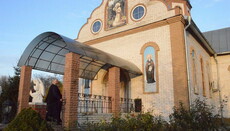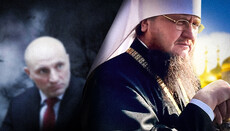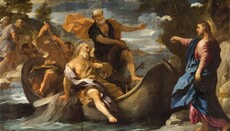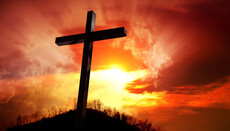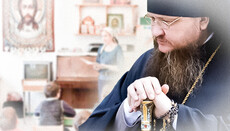Abbess Seraphima (Shevchik): "Ukraine’s strength is in its Orthodox faith"
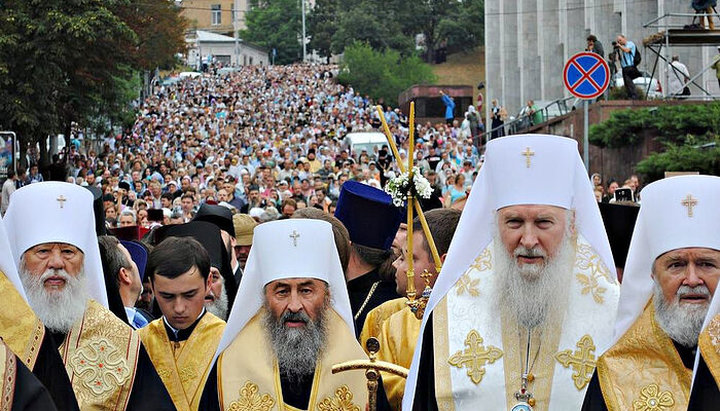
A Talk with Abbess Seraphima (Shevchik) for the 30th Anniversary of the Ukrainian Orthodox Church.
2020 is a jubilee year for the Ukrainian Orthodox Church: Thirty years ago, in late October 1990, Patriarch Alexy II signed the Letter granting the Ukrainian Orthodox Church the independent status with broad rights of autonomy. Since then, the canonical Church in Ukraine has faced all sorts of trials, including a bloody schism and open persecution from the powers that be.
Our conversation with Abbess Seraphim (Shevchik), a member of the Inter-Council Presence of the Russian Orthodox Church and head of the Ukrainian Church’s Synodal Church and Culture Department, concerns this difficult, sometimes dramatic period. Mother Seraphima is the author of more than twenty books and monographs dedicated to the life of the UOC and the history of Orthodoxy in Ukraine, the organizer and director of the Orthodox Ukraine and Christian Odessa museums, and numerous exhibitions and conferences, the latest of which were dedicated to the thirtieth anniversary of the Ukrainian Orthodox Church.
Thirty years ago…
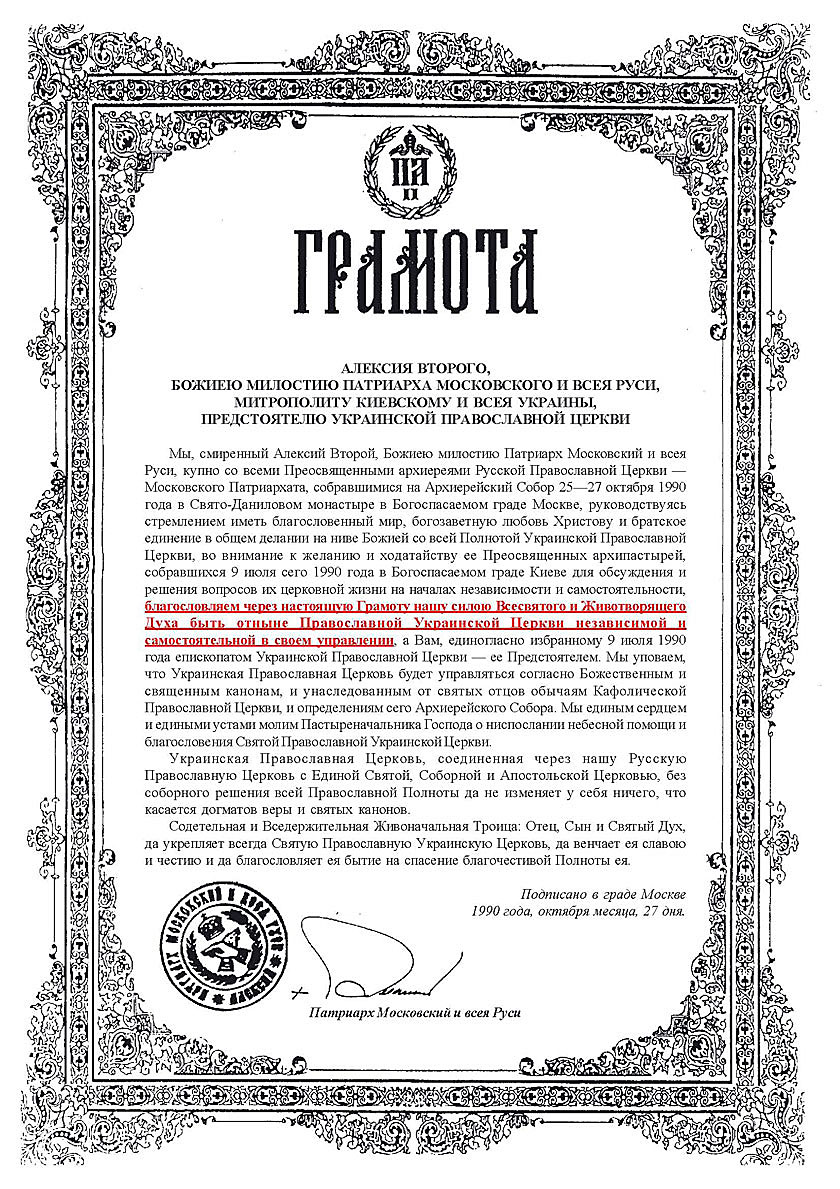
Before our conversation with Matushka Seraphima, we would like to remind our dear readers of some historical and political fragments of that distant period that preceded Patriarch Alexiy II’s granting of the Letter (Gramota), or as it is called now, the tomos, granting independence and self-governance to the UOC.
In late 1989, after Mikhail Gorbachev’s visit to the Vatican at the request of Pope John Paul II (1978-2005), the first Polish-born pontiff, the Ukrainian Greek Catholic church, which cooperated with the German occupiers during the war and ceased to exist in the USSR in 1946, was reanimated. A wave of seizures of Orthodox churches and cathedrals swept throughout western Ukraine; Orthodox clergy and their families were driven out of Church rectories onto the streets and were subject to violence and persecution.
In February 1990, Archbishop Makary (Svistun; † 2007) of Ivano-Frankivsk locked himself up in Holy Resurrection Cathedral in protest of the raiding by the Greek Catholics and declared an indefinite hunger strike, which caused a mixed reaction in the Council for Religious Affairs of the USSR—Vladyka was removed from the see by the decree of Filaret Denisenko, at that time a lawful hierarch of the UOC.

Also in 1989, the Council for Religious Affairs of the USSR registered the “Ukrainian Autocephalous Church of the Kiev Patriarchate,” which emerged in Ukraine in the early twentieth century, born in the scum of the revolutionary upheavals of 1919-20 and popularly known as the “self-consecrators—Lipkivskyites” (after the name of the leader of the Ukrainian schism Vasily LIpkivsky)—supported by the Bolsheviks to weaken the Russian Orthodox Church in Ukraine, and which ceased to exist in the USSR in 1937.
Among the activists of the Ukrainian schismatics was the future “Patriarch” of the UAOC Mstislav (Skrypnyk, 1898-1993), then still the layman Stepan Ivanovich Skrypnyk who was the nephew of Simon Petliura and served in the latter’s Ukrainian National Republic troops as a personal adjutant, who was “ordained” in 1942 during the Nazi occupation, and fled to Canada and American after the war.
On June 5, 1990, at the 1st Council of the UAOC in Kiev, Mstislav was elected the “Patriarch of Kiev and All Ukraine”, and in October of the same year, he returned to Ukraine and visited Kiev and Lvov. On November 18, 1990, with the kind permission of the authorities, he was “enthroned” in St. Sophia Cathedral in Kiev. Mstislav became the first “Patriarch of the UAOC”. After the fall of the USSR in 1991, he arrived in Kiev from the U.S. again in July 1992, and by order of the first president of Ukraine, he was generously provided with the former sanatorium of the Central Committee of the Communist Party of Ukraine in Puscha-Voditsa, near Kiev, where Mstislav met with Ukrainian President Leonid Kravchuk on July 2.
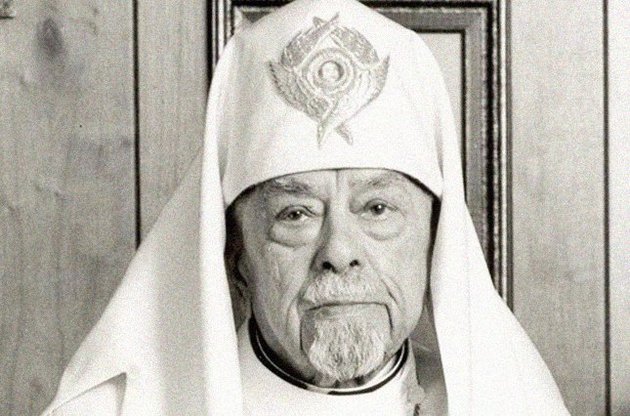
Additionally, public national-patriotic movements became active in Ukraine, the radical representatives of which waged an open campaign against the Ukrainian Exarchate of the ROC, and after the exarchate was granted independence—against the canonical Ukrainian Orthodox Church.
In 1992, Ukrainian Orthodoxy suffered a new calamity in the person of the schismatic Filaret Denisenko, a formerly lawful hierarch who was the exarch of the Ukrainian Exarchate of the ROC for many years. Accepting the Letter of independence and self-governance from the hand of His Holiness Patriarch Alexy II, Filaret hoped to achieve full autocephaly in the future, with the title of “Patriarch of All Ukraine.”
Fulfilling the duties of Locum Tenens after the death of Patriarch Pimen († 5/30/1990), he could not bear defeat in the election of the Patriarch of Moscow and All Russia at the Local Council of the ROC in June 1990. The author of these lines, then working in the Metropolis of the UOC as editor of an Orthodox newspaper, witnessed how the klobuk of the Patriarch of Moscow was sewn for Filaret and how containers full of his things were prepared for moving to Moscow. But the future schismatic suffered a crushing defeat in the Patriarchal election, receiving only 66 votes in the election held at the Danilov Monastery in Moscow, against 139 for the future Patriarch Alexy (Ridiger), and 107 for Metropolitan Vladimir (Sabodan), the future Primate of the Ukrainian Orthodox Church.

As we can see, even on the eve of gaining independence and self-governance, and in the subsequent period of its activity, the Ukrainian Orthodox Church has born the cross of great trials.
“The people of God united around their hierarchs”

We found Mother Seraphima in her office at the Odessa Archangel Michael Convent, which she has led for twenty-five years now.
She was negotiating the selection of exhibits for the next exhibition just then. Having finished her conversation, despite being so busy, she kindly agreed to speak with some Kiev journalists.
—Mother Seraphima, recalling the events of thirty years ago, tell us: How do you think the Ukrainian Orthodox Church today evaluates its reception of independence in 1990? After all, you were a novice at the famous Kiev Holy Protection Convent then, founded by St. Anastasia—the Grand Duchess Alexandra Petrovna Romanov, and which was among the monasteries of Ukraine that protested against the dictatorship of Filaret.
—All of us, the children of the Ukrainian Orthodox Church, are clearly convinced today of how right a step it was for the Holy Synod of the ROC and His Holiness Patriarch Alexy II to grant the UOC the status of independence and self-governance in 1990. We can confidently say now that this historical act took place by the ineffable providence of God; that is, the Ukrainian Orthodox Church has taken its rightful place in the Orthodox world and is truly autonomous, independent, self-governing, and unique in its structure. I think not even all the Local Churches that were granted autocephaly by Constantinople possess the same scope of rights as the UOC.
—But now we have a new trial: the interference of the Patriarch of Constantinople in the life of the UOC—a new schism, now with the participation of the hierarchs of Istanbul.
—These non-canonical and immoral actions of Constantinople have caused pain in the family of the Orthodox Churches. As you know, many of them have shown unanimity with our Ukrainian Orthodox Church. They recognize His Beatitude Metropolitan Onuphry as the sole lawful primate of the UOC and the majority are opposed to the politics of Istanbul.
—Matushka, let’s go back to the swashbuckling 1990s.
—Yes… Our Church received an impetus towards independent development, but from the very first days of the early 1990s, it found itself in the extremely difficult conditions of all kinds of provocations from the former Metropolitan Filaret and from the authorities, who strongly supported the schismatics.
Filaret wanted to become Patriarch of Ukraine any way he could, and he went to every length to achieve his goal: He deposed dissenting bishops and committed many unseemly deeds. But the healthy forces of the Church united and cured this disease. This is the value of the process of Church recovery and self-purification.
Filaret wanted to become Patriarch of Ukraine any way he could, and he went to every length to achieve his goal.
Despite internal vicissitudes, the actions of schismatics, and political attacks, life itself has testified that the canonical Church has a healthy core that the gates of hell cannot overcome (cf. Mt. 16:18). The people of God are united around their hierarchs, including Metropolitan Onuphry, Vladyka Agafangel, Vladyka Alypy, and others. A historical Bishops’ Council of the UOC was held in Kharkov in May 1992, which gave a canonical evaluation of Filaret’s actions, elected a new legitimate primate—His Beatitude Metropolitan Vladimir (Sabodan, † 7/05/2014), and placed a limit on the Church turmoil and unrest. In fact, the Church had reached a new historical milestone, passing through the fiery trial of schism and persecution.
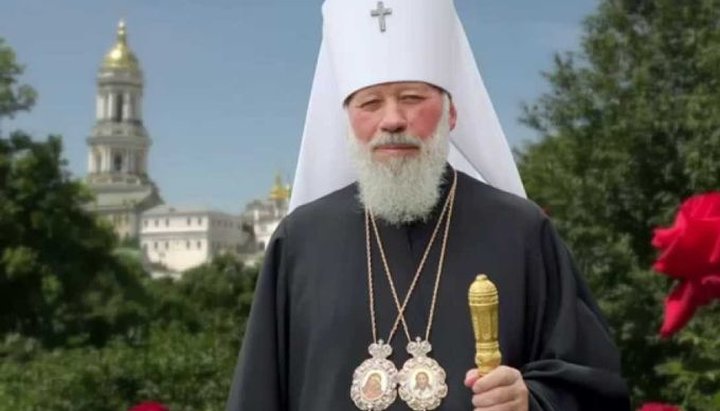
—However, the Verkhovna Rada [Parliament] issued a resolution on the illegality of the Kharkov Council, so the authorities at that time supported Filaret. Even the Bolsheviks didn’t do that. You had your obedience then at the Holy Protection Monastery and witnessed these events. As far as we know, not a single monastery in Ukraine supported the schism. Do you remember how the sisters and you personally reacted?
—Monasticism showed its strength then and gave a weighty word. For example, the monks of the Holy Dormition Monastery in Odessa sent a letter to His Holiness Patriarch Alexy II in which they categorically rejected Filaret’s idea of autocephaly and expressed unity with the Moscow Patriarchate. Other monasteries did the same, unanimously expressing unity with the Mother Church.
If we recall the Holy Protection Monastery at that time, Matushka Margarita (Zyukina, † 2005)—her memorial falls right on November 10—our blessed eldress and abbess was very worried and increased her prayers together with all the sisters. This conciliar prayer of the monastics, bishops, and laity gave a way out of the intolerable situation created in the Church by Filaret’s ambitions and authoritarian actions.
When Metropolitan Vladimir arrived in Ukraine, I think you could say it was a national assembly.
And when Metropolitan Vladimir arrived in Ukraine, I think you could say it was a national assembly: Representatives from every diocese in Ukraine and a crowd of thousands of lay people came to meet Vladyka, blocking all the streets by the station; and there was a grand procession from the station to the Lavra. Then the primates of every, I emphasize every, Local Church in the world sent written greetings to the newly-elected primate of the UOC Metropolitan Vladimir, thereby confirming that world Orthodoxy recognizes only our Church as lawful in Ukraine, as part of the Russian Orthodox Mother Church.
—The Church has endured and still endures great trials coming from the political elite of the country, various parties, and radical nationalist forces’ interference in its life.
—Absolutely true. Let’s recall at least 2008 when President Viktor Yushchenko invited Patriarch Bartholomew to Ukraine without informing Metropolitan Vladimir. And he came, knowing that it violates the canons of the Church, which state that a hierarch of any Church cannot visit the territory of another Church without an invitation [from the local first hierarch]. But Patriarch Bartholomew came to Ukraine anyways, positioning himself as the rightful hierarch of this land, and he met with President Yushchenko. He received attention at the highest level of government. Already then, without the participation of the UOC, the presidential administration was holding separate negotiations on autocephaly, about giving the “Kiev Patriarchate” the status of legality, of creating an Istanbul dependency in Kiev, and so on. Oh, but what a reaction from the faithful to the visit of the guest from Istanbul!...

Patriarch Bartholomew and Patriarch Alexy met on Vladimir Hill on the day of 1,020th anniversary of the Baptism of Rus’. The people of God, who crowded the slopes of the park around the hill, received the guest from Constantinople coldly, but joyfully applauded His Holiness [Patriarch Alexy]. I was standing not far away and could see how Patriarch Bartholomew bowed his head low and was looking at the ground. And when the people started chanting: “Our Patriarch is Alexy!” he winced, lowered his head, and hunched his shoulders. Then the state project failed. Yushchenko himself left the Divine Liturgy after the first exclamation, so affected was he by the shouts of the people and the absolutely clear expression of the position of the many thousands of the flock of Ukrainian Orthodoxy. Yushchenko was as if carried away from the square…
And one other detail: Our Church didn’t participate when the protocol for Patriarch Bartholomew to serve in St. Sophia Cathedral for the 1,020th anniversary of the Baptism of Kievan Rus’ was drawn up, by no fault of our own—we were simply cut out, and Yushchenko demanded that Filaret serve with Bartholomew. But Bartholomew was forced to reject this scenario, shamefacedly explaining to Yushchenko that the schismatic Filaret had no right to serve with him. So, Yushchenko asked that Filaret at least be allowed to stand nearby and pray, either in the altar or at least in the church. This was also refused. Bartholomew understood then that this step could mean his condemnation by the whole of world Orthodoxy. So, the service in St. Sophia was held without the head of the “Kiev Patriarchate,” but with His Beatitude Metropolitan Vladimir. On July 27, 2008, there was a service on Vladimir Hill, with the participation of Patriarch Alexy II, Patriarch Bartholomew, His Beatitude Metropolitan Vladimir, and the primates and representatives of all the Orthodox Churches of the world. The Lord did not allow the schismatics to participate.

—However, the authorities’ attempts to tailor autocephaly for their own uses did not stop…
—Absolutely correct. Viktor Baloga, the head of the presidential administration, together with the president’s brother Petro Yushchenko, was constantly going to Istanbul, holding backroom negotiations. And now, the second Maidan, “the revolution of dignity,” the invasion of Ukraine by American politicians, and Petro Poroshenko, finally implemented a project that is destructive for all of world Orthodoxy. Bartholomew, as they say, “ripened” under the affectionate wing of overseas patrons to commit a new schism in Ukraine, the likes of which hadn’t been seen for centuries. This situation is unacceptable, catastrophic—comparable only with the schism of a thousand years ago when Rome and Constantinople anathematized one another and parted forever, creating two completely different confessions.
By the way, I think it would be appropriate to recall 1997 when Patriarch Bartholomew went to Odessa to meet with Patriarchs Ilia II of Georgia and Alexy II, and at the final conference dedicated to the visit, clearly and unequivocally declared that he recognizes the UOC with His Beatitude Vladimir as the sole canonical Church in Ukraine. Is this not clearly Jesuitism?!
—Thus, the modern policy of Istanbul contradicts itself.
—Moreover, it’s amoral. When Bartholomew says that “we are the Mother Church” and “we are concerned for our daughter Church,” we want to recall that time, more than 300 years ago, when the so-called “mother” sold its child for money, and this is an indisputable fact. It will always remain a most shameful stain in the life of Constantinople.
Constantinople’s mistake, or more precisely, its villainy is obvious: Once again, they are deciding our faith without the people of God, basking in their own geopolitical interests, but not those of the faithful of Ukraine. All of these backdoor negotiations with the participation of Poroshenko and secret visits to the Phanar by Ukrainian politicians look like a betrayal of the multi-million Orthodox flock.
When the so-called “unification council” was held at St. Sophia’s in Kiev with the proclamation of Bartholomew’s tomos, everything was veiled in the greatest of secrecy; everything all around was cordoned off by the police and special services, and all the participants in this lawless deed behaved like thieves in the night… A shameful action… It is clear to a simple babushka, and even to the not-very-informed Church youth, not mention those of the older generations, where is truth and where is a lie. And the people, Orthodox society, the people of God will defend the truth and protect their faith and their holy sites from the invasion of impostors and schismatics. And if necessary, they will lay down their lives.
Over these thirty years of existence, the UOC has proven that it is a great national force, in absolute unity with its primate, hierarchs, and monastics. It is a powerful, mighty monolith. The last cross procession in Kiev, which numbered 300,000 people, proves this.
People will defend their faith, their shrines from the encroachments of impostors and schismatics.
—The Holy Fathers have said that if the Church as a whole and every believer in particular does not experience any difficulties, shocks, and temptations, it doesn’t contribute to spiritual growth. Can we say that the Church becomes stronger due to such periods?
—Our Lord Jesus Christ preached for all the ages: Blessed are they which are persecuted for righteousness’ sake: for theirs is the Kingdom of Heaven (Mt. 5:10). On the one hand, trials associated with state policy, with the backdoor influence of foreign figures who try to run things in the Ukrainian land, which is foreign to them, are always painful and cause great harm. Some parishes, having a political orientation, have left us. His Beatitude Vladimir said that we always pray for our brothers who are in schism. He never tired of appealing to them with great love and fatherly exhortation to return to the bosom of the Mother Church.
And now, Metropolitan Onuphry appeals to the conscience of those who left the Church. These are wounds that our enemies, ill-wishers, or simply erring people inflict upon the body of the Church.
But, on the other hand, our Church can rightly be called a martyric Church. When I see footage of people in camouflage with Right Sector armbands, swearing and shouting, with rebar and weapons in hand, throwing bloodied elderly people out of churches, beating priests, cutting locks, kicking down church doors—in a word, rioting—my heart bleeds.
—Mother, but in times of trials, the Orthodox people are mobilized, illustrating unity and readiness to defend their holy sites. This is how it’s been for the whole thirty years of our independence.
—It’s enough to recall the All-Ukrainian Cross Procession in 2016 when Ukraine was burning with the fire of confrontations between east and west, and people were dying in the eastern part of the country. The cross procession demonstrated the true united faith of the inhabitants of eastern and western Ukraine, when the faithful from various regions of the country simultaneously left the Sviatogorsk Lavra in Donetsk region and the Pochaev Lavra in Ternopil region, with wonderworking icons, going out to meet each other.

I remember the rabid verbal obstruction that crashed down on the Ukrainian Orthodox Church, its primate, and the participants in the procession. Our opponents had such hatred for our Church that they were ready to spill blood.
When the column reached Boryspil, the Minister of the Interior Arsen Avakov said grenades were found on the roadside—someone was planning a terrorist act. I saw footage of people from radical organizations throwing rocks at icons and crosses, throwing eggs, water bottles, and tearing icons from the hands of the processers. One of them seized a cross, and the people could barely get it back as the man raved and raged.
Never in the history of Ukraine has there been such a shame.
Never in the history of Ukraine has there been such a shame. On the contrary, the Cossacks of Ukraine defended the Church in battle, shedding their blood for it. The Zaporozhyians declared that they were protecting Orthodox holy sites. And then people who call themselves patriots of Ukraine, heirs of the glorious Cossacks, commit such atrocities—what reason and spirituality we can talk about here?!
And at the time when people from the west and east were processing towards one another, almost all the media, government representatives, representatives of the Cabinet of Ministers, representatives of the Presidential Administration, from the highest offices, declared it to be a “fifth column,” “enemies of Ukraine,” and so on.
I asked some of them: “Tell me, please, where these people are going? You say they’re the enemies of Ukraine. But where are they going? They are going to Kiev, to the capital of Ukraine, to unite east and west, to unite the parts of Ukraine that you have separated. So, who are the enemies of Ukraine? Those who call for a schism along ethnic and linguistic lines, or those who, on the contrary, try to reunite Ukraine with the help of simple people?”

And these two cross processions, as well as many other processions from various dioceses of Ukraine, united into one grand procession on July 27, 2016, the eve of the feast of Prince Vladimir, the Baptizer of ancient Rus’.
I still have this picture before my eyes: a sea of people, with His Beatitude Metropolitan Onuphry standing in the centre with his brothers, the archpastors, monastics, and dozens of wonderworking icons from all Ukrainian dioceses floating above the people along the central Kievan streets.
I would call this procession the pinnacle of the thirty years of the UOC. It was a great national prayer by believers from every province, every corner of Ukraine in its golden-domed capital, Kiev.
Our Church is strong in its inextricable connection with the Heavenly Church.
—There are testimonies of miraculous healings for people who risked everything to walk in the procession.
—We believe that the entire host of saints of ancient Rus’ and modern saints of our Church to whom we pray were present. Our Church is strong in its inextricable connection with the Heavenly Church. We see this by the miraculous events that have accompanied our flock over the course of the last three decades. Recall the 1990s: poverty, devastation, a lack of everything, and complete bewilderment for the majority of our citizens. And, in spite of this, how many beautiful churches were built and rebuilt? About 7,000 parishes were created!
In 2001, the Holy Dormition Cathedral of the Kiev Caves Lavra, built by St. Theodosius of the Caves—the greatest national holy site, blown up in 1941—was rebuilt. And again, it wasn’t without provocations. When President Leonid Kuchma and His Beatitude Metropolitan Vladimir went to the consecration of the cathedral, pseudo-patriot-nationalists staged mayhem, trying to prevent the event. Nevertheless, the sacred site was consecrated. Or the Holy Transfiguration Cathedral in Odessa—a masterpiece, recognized as a national treasure of Ukraine—was restored thanks to the help of the simple people and all the enterprises of the Odessa region. Or St. Vladimir’s Church in Chersonese, the site of the Baptism of Prince Vladimir; or the beautiful cathedral in Ternopil, where every single church was taken from us; or the magnificent new Holy Transfiguration Cathedral in the Pochaev Lavra—a miracle of light. Are these not testimonies of our faith and God’s help?!
And, of course, the Church’s greatest and most important wealth is its people—every person, and those who have served and are serving for the good of the Church by their firmness in defending Orthodoxy, their wisdom in Church building, and their apostolic preaching. This includes hierarchs, clergy, monastics, and the numerous representatives of the people of God.
Remembering the past, contemplating the present, you understand that the strength of Ukraine is its Orthodox faith!
—Mother Seraphima, you have spoken with His Holiness Patriarch Kirill many times. What are you most vivid impressions from these conversations?
—Having just taken up the difficult cross of the primatial ministry, His Holiness Patriarch Kirill’s first visit abroad was to Ukraine, in 2009. As a member of the working group that was created to quickly resolve the issues that arose, I had the good fortune to accompany him all around Ukraine. We went to Kiev, Crimea, western Ukraine, Donetsk, Pochaev. Although there were provocations in Volyn and other western Ukrainian places—pickets on the roads with political placards; local authorities banning the technical provisions for His Holiness’ trip—the trip still took place.
If not for the corridor of police, I would have been torn to pieces—such hatred was boiling in this crowd.
I was late to meet him in Lutsk because of some obstacles on the road. The Patriarch’s car passed through earlier, but when they saw me, the dissatisfied demonstrators pounced on me with profanity and abuse. I walked calmly and smiled, nodding to the enraged faces, and if not for the corridor of police, I would have been torn to pieces—such hatred was boiling in this crowd. Then I saw our faithful and Vladyka Niphont of Volyn, now reposed, who addressed the Orthodox parishioners [in Ukrainian]: “Children, are you glad that His Holiness the Patriarch has come to visit us? Welcome him!” And then the entire crowded square became excited, began to buzz, and began to chant: “Our Patriarch Holiness Kirill!” That’s how the people expressed their love for His Holiness.

I was struck by the fervent prayer with which His Holiness addressed God, asking for blessings and prosperity, grace and the help for the people of Ukraine and the Ukrainian Orthodox Church. He put his whole heart into this prayer, and I felt how concerned he was for our country. In the cities of Crimea, especially in Chersonese, at the site of the Baptism of Prince Vladimir, there was also a ton of people. People began walking at dawn to get to where His Holiness was serving. These were unforgettable moments when we felt the presence of the Baptizer of Kievan Rus’ himself in this holy place.
These were unforgettable moments, when we felt the presence of the Baptizer of Kievan Rus’ himself in this holy place.
Today, with the blessing of His Holiness, prayers are lifted up for Ukraine in every church of the ROC, and that’s not just in Russia, but in Belarus, in Kazakhstan, in Moldova—in sixty countries throughout the world. When we visited churches of Spain, Italy, Germany—everywhere, we heard how the parishioners pray for Ukraine. And at every service, His Holiness kneels and prays for the Ukrainian people, for peace in Ukraine. Who is our father? Who takes paternal care of us—the Patriarch from Istanbul, who wants to teach us with false insinuations from history? Or His Holiness Patriarch Kirill, whose love we actually feel? That’s a rhetorical question…

In the late 1990s, I came across an article in the chronicle of Philaret’s “Kiev Patriarchate” that was called “Why Should We Honor the Kazan Icon?” There were stupid ideas there: What does it have to do with Ukraine? It’s not our icon; we have to forget all these “Muscovite holy icons”! Venerated icons of the saints of Kievan Rus’, who laboured and worked wonders on the “cursed land of Muscovy,” simply disappeared from their menaion. When politicians say: “Better satan than Moscow,” pray tell: Where is the end of this hatred? It is in the realm of hell… When hatred leads to the oblivion of the names of the great righteous ones, I want to ask: Do these people have any connection with Heaven? Alas, this is the tragedy of the deluded.
And yet I want to believe that, as the Ecclesiast says, everything passes, and this will pass too. But the Lord abides forever (cf. Ps. 9:7) Amen.
Deacon Sergei Geruk
spoke with Abbess Seraphima (Shevchik)
